
Photo by Dennis Oehmke, courtesy of the Illinois Raptor Center Accipiter Nest Site Selection and Recreational Trail Use Effects at Pinnacles National Monument by Clay Fletcher During my life, I have spent much time searching for and watching the nests of a variety of raptors, from buteos such as red-shouldered and red-tailed hawks to golden and bald eagles to peregrine falcons and spotted owls. One of my favorite groups of hawks is the accipiters (genus: Accipiter) or woodland hawks - the goshawk, Cooper's hawk and sharp-shinned hawk. I favor this group of hawks for a variety of reasons including their beauty, boldness, speed, agility, and their secrecy. Accipiters are in general hard to observe and it is even harder to find their nests. The first accipiter nest I found was a sharp-shin's. It was located in a thick pine woodlot on my childhood farm in Virginia. The nest had already been deserted, but feathers and eggshell fragments gave the identity of the occupants away. Years later, I found other sharpie nests in California and Washington. While working as a biologist, I was employed to find and monitor goshawk nests in the eastern Cascades of Washington state, a challenge which I eagerly and successfully pursued. As I searched for and found nests, a question began to naturally develop in my mind, what is it about a particular spot that these birds find so attractive for nesting? In other words, why are nests placed in these spots and not somewhere else?
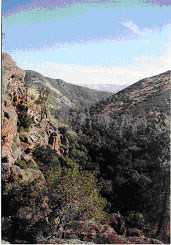
chaparral covered hillsides at Pinnacles National Monument. Photo by Clay Fletcher My project goals were to: 1) locate and map all Cooper's and sharp-shinned hawks nests at PNM; 2) determine nest site habitat characteristics (that is, attempt to answer the question: what's so special about nest sites?); and 3) examine the relationship between recreational trail use and accipiter nesting in terms of reproductive success and nest placement. The Cooper's and sharp-shinned hawk are both California Species of Special Concern. The results of my study will assist in effective management and preservation of these two sensitive species at PNM.
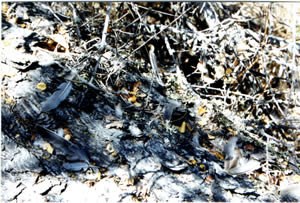
Photo by Clay Fletcher 
Photo by Dennis Oehmke, courtesy of the Illinois Raptor Center 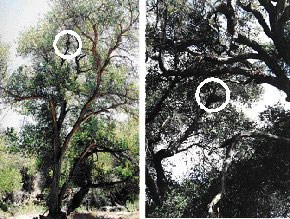
Photo by Clay Fletcher Between 1999 and 2001, I located 20 accipiter nests. Eighteen nests were Cooper's hawk, one was a sharp-shinned hawk and one was classified as accipiter because it was inactive and I could not positively identify which species built it. Sixteen nests (80%) were located in coast live oaks; two were in California sycamores; one in a Fremont's cottonwood and one in a gray pine. I monitored each nest by visiting the sites at least once every two weeks. Once the young had left the nests, I measured habitat characteristics surrounding nest sites. I centered a 37 ft radius circular plot on the nest tree and measured the diameter of all trees within the plot, the diameter and height of the nest tree, the height of the nest, canopy closure - the percentage of the plot covered by overhead foliage, slope, aspect, and distances to trail, creek bed and nearest water. 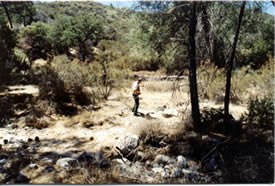
Photo by Roger Gambs This information was important for characterizing nest sites in a general way. However, as my goal was to determine if the birds were selecting certain habitat features, it was not enough to measure features only at nest sites. Nest site characteristics may be identical to characteristics found at any other wooded riparian location. It was therefore necessary to compare nest site features to features found at randomly chosen locations lacking nests. Differences in habitat characteristics between nest sites and random sites may point to important habitat features the hawks are looking for when choosing nest sites and thus may provide an answer to my original question: What is special about the places where nests are located? I took identical measurements (except those pertaining to nest placement) at randomly chosen sites not used for nesting; and, statistically compared habitat features at nest and random non-use sites. However, choosing random non-use sites for sampling was complicated by territorial behavior of accipiters as well as by the hierarchical, step-by-step (from larger to smaller spatial scales) nature of nest site selection. The choice of scale for locating random non-use sites may greatly alter study results and conclusions. A helpful analogy for understanding the selection process is to think of a person relocating to a new area: first they choose a geographical location; then a city; a neighborhood from those available within the city; and finally a lot within the chosen neighborhood, and a house containing various rooms on the chosen lot. Choices made at each level determine what is available at the next level. Using the analogy above, PNM can be considered a neighborhood for breeding accipiters. Within this neighborhood there are a number of approximately equally sized lots or tracts of land which are called Post Fledging Areas (PFA). PFAs provide a variety of resources such as potential nest sites, prey, water, and roosts for each breeding pair and their family. PFAs are presumably defended by resident pairs and provide a safe haven for their young to learn survival skills in after fledging. Consider that each lot has a number of potential homes on it and breeding accipiters choose one to live or nest in. This chosen home is a Nest Area. Within this chosen home or Nest Area a pair selects one room to nest in which I call a Nest Site. I was interested in examining selection on two spatial scales: the home (Nest Area) and the room (Nest Site) within the home. In other words, I wanted to know why birds chose one Nest Area over others available in their PFA and why they chose one Nest Site from among those available within the selected Nest Area - see diagram for sampling scheme. To address home or Nest Area selection, I used two methods. In Method 1, continuing with the analogy, I compared the types and sizes of rooms contained within the selected home (Nest Area) to the rooms in a home not occupied by the birds (Available Area). In habitat terminology, this was a macro or large scale comparison between Nest Areas and Available Areas where the rooms are equivalent to vegetation types. I characterized the dominant vegetation within these 2 types of areas using Geographical Information System (GIS) - a computer based mapping system where different layers of information (e.g. trails, streams and plant communities) can be overlaid on each other for analysis. I compared the proportions of the different plant community types found within both types of areas. In Method 2, I compared micro-habitat features of the Nest Site (room by analogy) within the selected Nest Area (home) to an available but unused nest site (room) within the Available Area (unused home). 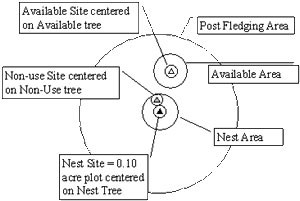
GIS (macro-habitat) analysis revealed differences in dominant woodland type found in Nest Areas compared to Available Areas. In Nest Areas, mixed riparian was the dominant woodland type, while blue oak woodland was the dominant type in Available Areas. Microhabitat analysis showed that Nest and Available Sites were different for the measured characteristics. The mean diameter of Nest trees was less than that of randomly chosen Available trees if all four species of trees were considered together (Available trees could be any one of the four species used by accipiters at PNM). However, if only coast live oaks (representing 80% of trees chosen for nesting) were considered in both groups there was no difference in mean diameter between Nest trees and Available trees. Canopy closure or percentage of site covered by overstory tree foliage, basal area (the total cross sectional area for trees in the plot), and total number of canopy trees per plot were all greater for nest sites compared to available sites. Furthermore, the number of trees in Nest Site plots were evenly distributed around the nest tree, while Available Site plots had fewer total trees per plot, plus an uneven spatial distribution. Thus, Nest trees were smaller than random Available trees and Nest Sites (0.10 acres) had more trees with a denser canopy (higher canopy coverage) than Available Sites. I also used Method 2 to compare Nest Sites to Non-use Sites (centered on a randomly selected tree of the same species as the nest tree) located in the same Nest Area. Analysis revealed no significant differences in micro-habitat variables between Nest and Non-Use Sites. However, there were indications that total canopy closure and canopy closure to the west were higher for Nest Sites. Furthermore, the spatial distribution of trees between these sites was different: at Nest Sites the trees were evenly distributed around the nest tree while Non-use Sites had fewer trees to the south half of the plot. Thus, accipiters at PNM selected a specific type of nest site from among sites available to them. Typically, nests were situated in the middle canopy of a coast live oak, with a tree diameter of 24 inches and tree height of 65 feet. The nest tree was located in the middle of a grove of six or more canopy trees equally distributed around the nest tree. The mean canopy closure of the site was 84% and closure percentage was approximately equal in each of the compass directions. Mean distance from nest trees to stream channels was 55 feet, which was the same as distance to water through May. However, as the breeding season progressed, the surface flow of many streams disappeared, and by early July (fledging time) the mean distance to surface water was 452 feet. These distances were not significantly different for Available Sites, indicating the presence of additional water sources within the PFA. The Nest Site (equivalent to the 0.10 acre sampling plot) was located within a 15 acre Nest Area that contained other similar potential nest sites. The Nest Area was located within a 282 acre post-fledging area (PFA). Besides additional water sources, Available Areas within PFAs contained a mixture of habitats, especially dominant woodland type, different from those found in the Nest Areas. How do these habitat characteristics help to increase the chance for successful breeding and survival of chicks for PNM accipiters? On the Nest Site scale, the high overall canopy closure and high closure in each of the cardinal directions may provide protection from inclement weather conditions (ie., extremes of both hot and cold) and predators (decreasing visibility of nests). The presence of similar habitat patches within Nest Areas may offer alternate nest sites (in case of nest failure); roost sites; and protection from predators. Post-fledging areas (PFA) offer a variety of habitat types and a dominant woodland type (blue oak) different from that found in Nest Areas as well as sources of water. These factors should provide a variety of prey resources for both adults Concurrently with studying nest sites, I collected trail-use counts (i.e. the number of people using a given trail) for both 2000 and 2001 with infra-red counters deployed on the major trail systems of PNM. Based on trail counts, I classified trails containing accipiter nests into high or low use categories. Seven nests were located along high-use trails and 13 were along or associated with low-use trails. I compared nest placement and site characteristics of these two groups. The results suggest that nesting accipiters may be screening their nests in response to recreational trail use. A visibility index (an average measure of how difficult a nest was to see from five points on the ground) was higher for nests adjacent to high use trails as compared to those along low use trails thus indicating that high use trail nests were more difficult to see from below. Canopy closure was also greater for nests adjacent to high use trails. A higher canopy closure reflecting a denser canopy would obviously be associated with a higher degree of visual screening and thus a higher visibility index. I observed no significant difference in reproductive success between the two trail use groups; that is, both groups produced approximately the same number of young per nest. Of the two nest failures during the study period, one was associated with a high use trail (immature female) and the other with a low use trail (mature female). What are the conclusions that can be made from this study? First, accipiters at PNM are similar to accipiters world wide in choosing nest sites based on woodland structure - PNM accipiters chose sites with a greater number of trees, higher basal area and higher canopy coverage compared to available sites. Second, there was year to year variation in the population of breeding accipiters in the Monument. I cannot conclusively say that this fluctuation in territory reoccupancy was related to the intensity of recreational trail use, but my study suggests that was at least partly the case. The nests along high use trails received more disturbance. Disturbance can directly and indirectly affect nesting birds: directly by causing them to leave the nest more often and to spend energy in nest defense behaviors which can interrupt normal prey deliveries. These direct effects may ultimately result in lower nutritional status of the young and may indirectly lower their chances for successful breeding in the future. Furthermore, repeated disturbance can desensitize and habituate the young accipiters to humans, which has been found correlated with higher mortality later in their life. The birds appeared to visually screen their nests more along high use trails possibly for minimizing exposure to disturbance from hikers. High trail use nest sites may be in low quality habitat (because of trail disturbance) and are only occupied by breeding pairs in years when there is an abundance of adults in the population. In years when there is a shortage of breeding birds, only the high quality sites along low use trails may be occupied. Management recommendations include: 1) continued monitoring of accipiter nesting at PNM; 2) collection of more information on reoccupancy of nests along high use trails, in particular; and 3) preservation of mixed riparian woodland habitat (preferred nesting habitat) through management and restoration of natural stream geophysical dynamics. Also, creating buffer zones around active nests and perhaps limiting group size on high-use trails may be important for maintaining a healthy population of breeding accipiters. Educating visitors on the importance of minimizing disturbance, especially in terms of noise levels, may be another tool to insure the long-term viability of accipiters at PNM. Another recommendation concerns trail location. The woodlands in the riparian corridors are very narrow - less than 150 feet in many locations. Because of their location in the middle of the corridor and their tendency to cross from side to side along streams, many trail locations at PNM result in some fragmentation of riparian woodlands. Their meandering course allows trail disturbance impacts to be manifested throughout the woodlands. It may be better to locate trails on one side of the stream only, the side which avoids the most quality habitat. The application of these management recommendations should assist in maintaining accipiters at PNM, which is important for the overall health of PNM ecosystems. For example, Steller's and scrub jay - favored accipiter prey species - benefit from human use of PNM due to an increase in food sources (e.g., picnic food scraps) and an increase in edge habitat (i.e., habitat bordering trails or roads). Both jays are known predators of song bird eggs and nestlings. Many song bird populations, particularly Neo-tropical migrants (birds that spend the winter in Central and South America and breed in North America), are decreasing in numbers. Thus, through predation, accipiters may help regulate the number of jays which may, indirectly, help increase song bird populations. |
Last updated: February 28, 2015
